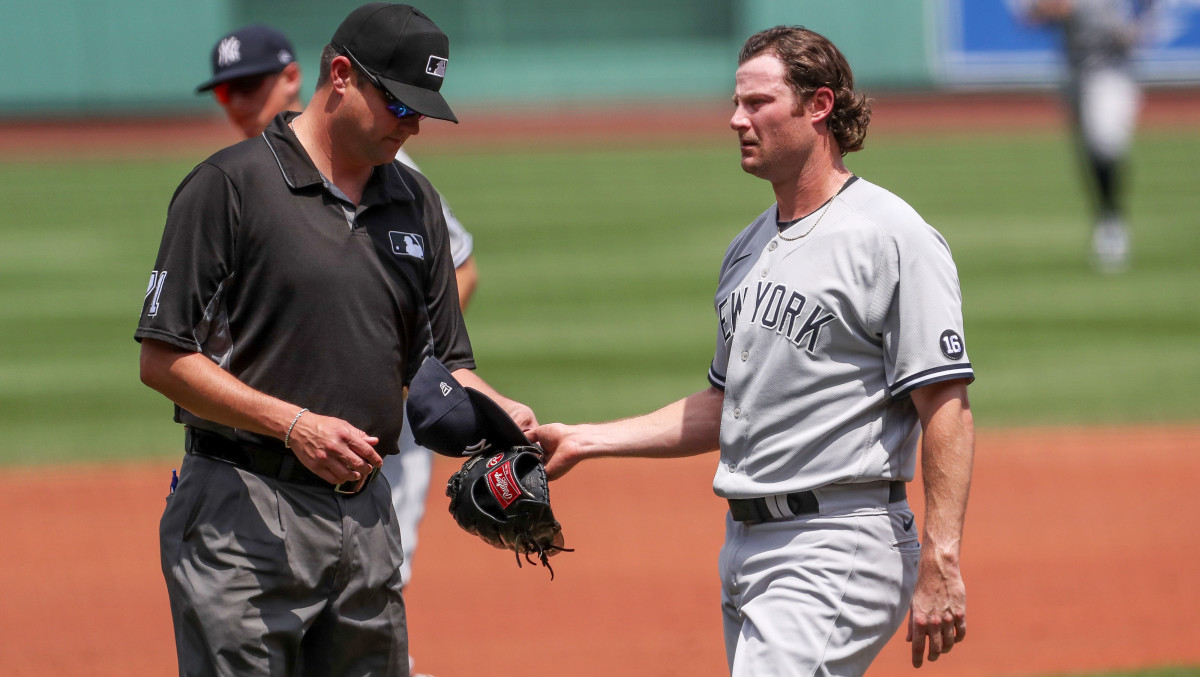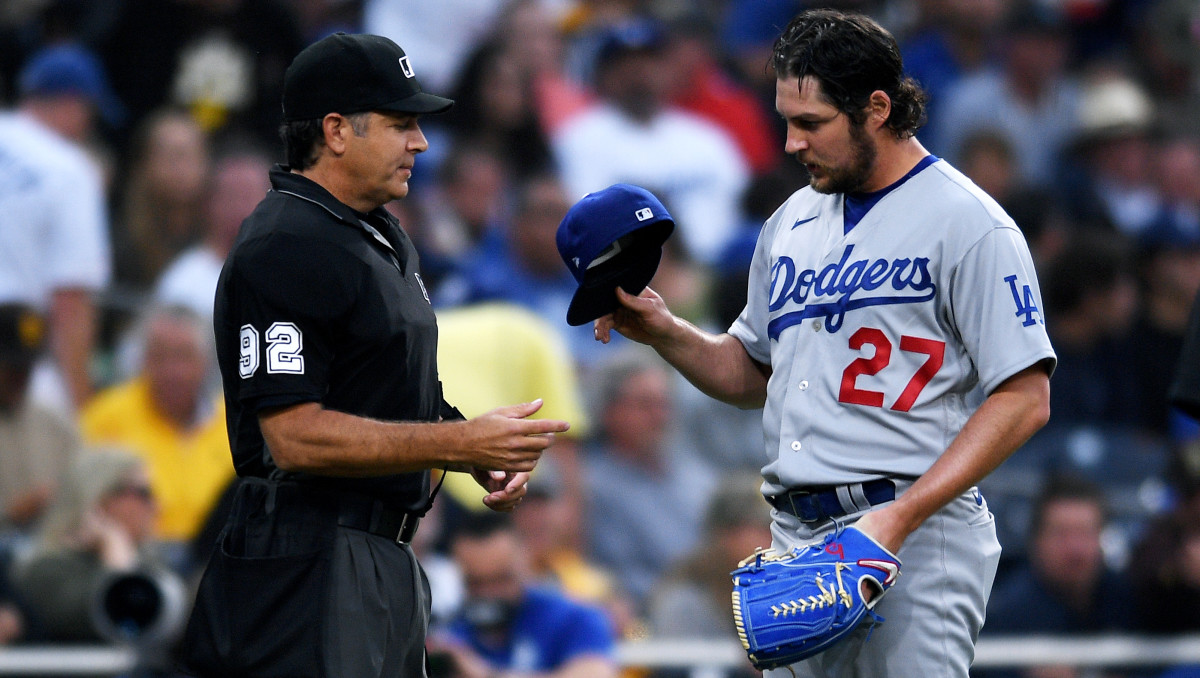Sticky Stuff Enforcement Is Already Making Baseball a Better, Fairer Game

Welcome to The Opener, where every weekday morning you’ll get a fresh, topical column to start your day from one of SI.com’s MLB writers.
The rebalancing of baseball has begun. The sport still needs to shape a more entertaining product by quickening the pace of play, outlawing shifts, reducing the strikeout rate and limiting pitchers on a roster. But some change is here. We have seen a drastic decline in spin rates in just the first week baseball began enforcing the ban on pitchers doctoring the baseball.
Baseball immediately became a fairer game and hitters have a better chance to put the ball in play. And if you don’t think those are urgent matters, then you are either a pitcher who rationalizes cheating or you haven’t been paying attention.

The early highlights of the Crackdown on Goo:
• “Super-spin” four-seam fastballs (2,500 RPMs or more) plummeted 69% in the first week of enforcement compared to the rate before June 3, when the unofficial warning period began. An average of 17.2 super-spin fastballs per game fizzled to 5.3.
• The MLB batting average on June 3 was .236, lower than any season in history. Since then, it is .243 (but only .234 last week).
• After the average four-seam spin rate rose five consecutive regular season months, it fell by 61 RPMs in June to the lowest in a regular season month since August of 2018.
• Of the 35 pitchers with the highest four-seam spin rate on June 3, 33 of them saw a decline in spin rate since then—by a drop of 96 RPMs.
• Twenty-seven of the 30 teams saw their four-seam spin rate decline last week compared to June 3. Teams lost an average of 87 RPMs just last week. The biggest drops: Tigers (-224), Dodgers (-169), White Sox (-159), A’s (-158), Angels (-156) and Brewers (-152).
Predictably, pitchers are whining. Some complained it was unfair for the crackdown to begin mid-season. Hello? MLB issued warnings before the 2020 season and before this season for pitchers to clean up their act. They didn’t. That’s why enforcement was needed.
The whine about “needing time” to adjust is akin to asking, “Can you please just let us keep cheating this year?” For a sport that was criticized for being late to clean up the steroid party, how do you square criticism now for coming down on a form of cheating that, as Cardinals manager Mike Shildt said, was being done in full view?
(As for that rationalization that “hitters want us to cheat so the ball doesn’t slip out of our hand and hit somebody” … the MLB hit-by-pitch rate in the first week of enforcement was 0.85 per game—virtually unchanged season rate of 0.86.)
Some pitchers are struggling without grip aids. Boston pitcher Garrett Richards complained the crackdown “has changed pretty much everything for me … I feel like I need to be a different pitcher than I have been the last nine-and-a-half years.”
From 2017 through May 2021, Richards spun his fastball at 2,604 RPMs. Hitters batted .281 against it. In June, his spin rate sunk by 120 RPMs and hitters have crushed it for a .380 batting average.
Pitchers are not solely to blame. Club officials zealously sought high spin rates, both on the trade and free-agent markets and in their player development systems. They created a reward system of jobs and money based on spin.
The Yankees gave Gerrit Cole $324 million after he won the 2019 ERA title with a 2,530-RPM fastball. This month his ERA is 4.65 with a 2,358-RPM fastball.

The Dodgers gave Trevor Bauer $102 million over three years after batters hit .172 last year against his 2,770-RPM fastball. This month they are hitting .320 against a fastball down to 2,582 RPMs.
Because Bauer is so astute about spin, let’s use Bauer as an example of the correlation between increased spin and less offense. Here is his career in three segments:
Bauer Four-Seam Fastball
Avg. | RPMs | |
|---|---|---|
2015-Aug. 2019 | .275 | 2,290 |
Sept. 2019-May 2021 | .225 | 2,750 |
June 2021 | .320 | 2,582 |
And this will give you an idea of why pitchers covet spin:
Bauer Fastballs by Spin Rate, 2015-21
RPMs | Avg. |
|---|---|
2,201-2,400 | .289 |
2,401-2,600 | .258 |
2,601-2,800 | .219 |
>2,801 | .128 |
Cole and Bauer absorb the bulk of scrutiny because they are two of the three highest paid pitchers in history based on average annual value, and because Bauer unofficially kicked off Goo-gate when in 2018 via Twitter he insinuated the Astros were boosting spin rates with sticky substances. Cole was on the Houston staff at the time. He added 215 RPMs to his four-seamer in his first year there.
But the problem has been widespread for years. The difference in the game last week was noticeable. Here are just three examples of obvious changed behavior:
• Before June, a rookie reliever was scraping his pitching fingers against the inside webbing of his glove after every pitch to load up on a sticky substance. Last week he was using the rosin bag and licking his fingers—something legal he did not dare do when he was cheating because of the toxic nature of his sticky substance. His spin rate dropped by more than 200 RPMs. After a particularly bad outing, he was sent back to the minors.
• A veteran reliever liked to wipe his pitching hand across the right back pocket of his pants after every pitch, loading up on a clear grip aid. Last week he stopped the habit. His four-seam spin rate suddenly fell by more than 200 RPMs.
• A veteran right-handed starting pitcher liked to rub his pitching hand across his left forearm after every pitch to load up on a clear lotion there. Last week he stopped the habit. His four-seam spin rate dropped by almost 200 RPMs and his slider spin rate dropped by 45 RPMs.
It’s important to remember that with sticky substances, like steroids, not all pitchers have been cheating. Among the top 25 four-seam spin rate pitchers on June 3, for example, Daniel Bard, Tanner Scott, Yu Darvish, Joe Musgrove and Ryan Pressly last week maintained elite spin rates more than 2,500 RPMs. These pitchers from that group, however, did show a noticeable drop:
Four-Seam RPM Decline, Last Week Compared to June 3
J.P. Feyereisen, Rays | -344 |
|---|---|
Corbin Burnes, Brewers* | -318 |
Lucas Sims, Reds | -307 |
Walker Buehler, Dodgers | -297 |
Dylan Cease, White Sox | -288 |
Garrett Richards, Red Sox | -282 |
Trevor Bauer, Dodgers | -233 |
Richard Rodriguez, Pirates | -232 |
Gerrit Cole, Yankees | -204 |
*cut fastball
How in the world did we get here? Look at MLB four-seam spin rates by month. You will see a gradual, steady rise starting in 2018—with spikes in postseasons when the best (and some would savviest) pitching staffs take the mound. The clear anomaly is this month with its sharp 61-RPM drop—made possible only by enforcement of the rules—which followed the highest regular season monthly spin rate in recorded history.
What does this mean for the rest of the year? The biggest effect seems to be the collapsing of the top end of spin rate. The use of sticky substances long ago jumped from “The ball is slick; I need a grip aid” to “I’m chasing as much spin as possible because higher spin means the pitch is tougher to hit.”
Consider this example. Let’s say I have an average fastball with a spin rate between 2,200 and 2,300. If I throw it right down the middle, hitters bat .329 against it. But if I boost my spin to 2,500 or more—same pitch, same location, just more spin—batters hit .292. That’s a 37-point reduction based entirely on using a grip aid to spin the ball faster. And the effect is even more pronounced if those fastballs are thrown to the upper third of the strike zone: a 51-point suppression of offense with the spin boost.
Fastballs that spin 2,500 RPMs or more are hard to hit. Batters hit just .218 against them, compared to .257 on pitches below that spin threshold. By reducing those super-spin fastballs from 17.2 per game with no enforcement to 5.3 per game last week, baseball should see an uptick in offense, fewer swings and misses and a game in which the guy with the best chemist doesn’t have an unfair advantage. Even with TSA-style pat downs—awkward but necessary considering how we got here—that is nothing but good for the game.
More Sticky Stuff Coverage:
• Sticky Cleanup: What Pitch-Doctoring Enforcement Means for MLB
• He Made Sticky Stuff for MLB Pitchers for 15 Years. Now He's Speaking Out.
• 'This Should Be the Biggest Scandal in Sports'
• MLB's Pitch Doctoring Scandal Goes Beyond Individual Offenders
